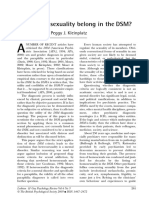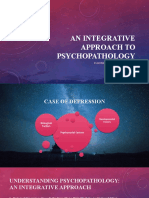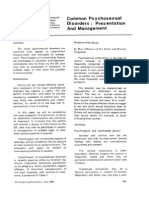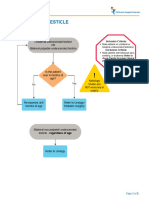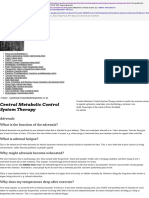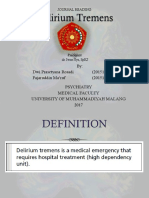A Handouts-PSY512 CH 7
A Handouts-PSY512 CH 7
Uploaded by
Maya GeeCopyright:
Available Formats
A Handouts-PSY512 CH 7
A Handouts-PSY512 CH 7
Uploaded by
Maya GeeCopyright
Available Formats
Share this document
Did you find this document useful?
Is this content inappropriate?
Copyright:
Available Formats
A Handouts-PSY512 CH 7
A Handouts-PSY512 CH 7
Uploaded by
Maya GeeCopyright:
Available Formats
Gender Issues In Psychology (PSY512) VU
omen are at a higher risk in sedatives, hypnotics, or anxiolytics (American Psychiatric
Association, 2000). Women are at a higher risk of panic attacks with and without agoraphobia
(ratio 2-3:1), and social phobias in women in general population (men higher in clinical settings).
There are no gender differences in Obsessive Compulsive Disorder or Posttraumatic Stress
Disorder (American Psychiatric Association, 2000).
Conversion Disorder is substantially more common in women than in men (ratio 2-10:1)
(American Psychiatric Association, 2000).
Women account for 95% of somatization disorder patients (Tomasson, Kent, and Coryell, 1991).
In the U.S, this diagnosis is rare in men, but not so in other cultures (American Psychiatric
Association, 2000).
There are no gender differences in Body Dysmorphic Disorder. Dissociative Identity Disorder is
more common in women with a ration of 3-9:1. Sexual dysfunction, Paraphilias is rarely
diagnosed in women, and the men to women ratio are 20:1.
©Copyright Virtual University of Pakistan 1
Gender Issues In Psychology (PSY512) VU
Lesson 43
GENDER AND PSYCHOTHERAPY
Most students doing an under graduate or graduate course in psychology are familiar with the
various perspectives or prevalent models in psychology. All of these models have their specific
approach towards the understanding and explanation of mental illness, as well as the therapeutic
interventions for treating these disorders. In our discussion on gender and psychotherapy we will
not go into the details of the commonly known psychotherapeutic approaches that may be around
400 in number.
It is assumed that you are already fully aware of these approaches. Our emphasis, in this segment
of this course, will be upon the feminist approach toward psychotherapy. As discussed earlier, the
feminist approach emphasizes women’s issues, the impact of socialization, gender stereotypes,
issues specific to women’s well being, and similar topics. Before starting our discussion on
gender and psychotherapy, let us try to find the answer to a question!
What is common between psychoanalysis, Behavioral Therapy, Client-Centered Therapy,
Existential Therapy and Rational Emotive Behavior Therapy?
If the question puzzles and confuses you, then think about another question!
What is common between Freud, Jung, Adler, Watson, Skinner, Rogers Maslow and Ellis??
We are sure that you have found the answer. In the former question, all the therapeutic
approaches mentioned were given by male psychologists. And in the latter, all the psychologist
mentioned are males. Not only that all these are male psychologists but, more than that they are
all male psychologists, from the west, all white.
In our discussion on gender and psychopathology, we mentioned that men are used as norms;
stereotypically masculine gender roles are considered as a standard. As a result, a behavior
deviating significantly from this norm, i.e., feminine behavior, is likely to be identified as
pathological. A similar trend has been observed, and can always be expected, in the therapeutic
intervention if the therapeutic process is male-dominated, male-centered, and male-controlled.
As a result of the feminist movement of the 1960s, psychological approaches, and therapeutic
interventions also saw a shift in focus. Psychotherapists with a feminist approach do not deal
with, and understand, pathology in the same manner as a conventional therapist would usually do.
We find two key elements at the core of the feminist therapeutic process:
a) Gender
b) Power
©Copyright Virtual University of Pakistan 2
You might also like
- Psy 512 CH 42Document4 pagesPsy 512 CH 42Maya GeeNo ratings yet
- Module 1 Unit 1 Clin - PsyDocument4 pagesModule 1 Unit 1 Clin - Psyrosemaryrobin04No ratings yet
- Short Notes On Abnormal Psychology - 113109Document23 pagesShort Notes On Abnormal Psychology - 113109kizzdonielNo ratings yet
- Day 1 Intro RV Rushed Version For 2018Document30 pagesDay 1 Intro RV Rushed Version For 2018api-391411195No ratings yet
- Psychological DisordersDocument4 pagesPsychological DisordersCarlyn HarfordNo ratings yet
- Abnormal Psychology Lecture 1 IntroductionDocument15 pagesAbnormal Psychology Lecture 1 Introductionkatiemcclung01No ratings yet
- Sex AddictionDocument11 pagesSex AddictionNgari MwanikiNo ratings yet
- Psychotherapy For Treating Anxiety DisordersDocument11 pagesPsychotherapy For Treating Anxiety DisordersShaista ArshadNo ratings yet
- Areas of Psychology Lecture 1Document6 pagesAreas of Psychology Lecture 1Dondurma AmorNo ratings yet
- Does Heterosexuality Belong in The DSM?: CommentaryDocument7 pagesDoes Heterosexuality Belong in The DSM?: CommentaryabibubiNo ratings yet
- Anxiety Disorder and Its TypesDocument32 pagesAnxiety Disorder and Its TypesWiwi Wulandani AbNo ratings yet
- Mental Disorders Which Mental Disorders Are More Common in Women?Document6 pagesMental Disorders Which Mental Disorders Are More Common in Women?Viplav BhatiaNo ratings yet
- Whitbourne7e IM Ch08Document8 pagesWhitbourne7e IM Ch08Antônio Malvar Martins NetoNo ratings yet
- Anxiety Disorders and Suicidal Behaviour: An Update: Jacinta Hawgood and Diego de LeoDocument14 pagesAnxiety Disorders and Suicidal Behaviour: An Update: Jacinta Hawgood and Diego de LeoNeiler OverpowerNo ratings yet
- Psychiatric Medicine II The Sexual Disorders Meg Kaplan, PH.DDocument10 pagesPsychiatric Medicine II The Sexual Disorders Meg Kaplan, PH.DPradeep100% (1)
- Is A Psychodynamic Perspective Relevant To The Clinical Management of Obsessive-Compulsive Disorder?Document12 pagesIs A Psychodynamic Perspective Relevant To The Clinical Management of Obsessive-Compulsive Disorder?RavennaNo ratings yet
- Pro 31 4 372Document6 pagesPro 31 4 372jamidfNo ratings yet
- Assignment of Pathology by NayabDocument3 pagesAssignment of Pathology by Nayabriazmaryam143No ratings yet
- Branches of PsychologyDocument7 pagesBranches of PsychologyNickhie BajadaNo ratings yet
- Chapter 2 Western and African Aetiological Models 2024 - 110812Document56 pagesChapter 2 Western and African Aetiological Models 2024 - 110812mihlemaza03No ratings yet
- Allie Cannon Anxiety Case StudyDocument9 pagesAllie Cannon Anxiety Case Studyapi-349885103No ratings yet
- Sex Tera PieDocument2 pagesSex Tera PieJeni ChiriacNo ratings yet
- Types of psychology-BACDocument9 pagesTypes of psychology-BACIvonneNo ratings yet
- PsychoSexualPsych PDFDocument7 pagesPsychoSexualPsych PDFtonyNo ratings yet
- Mental Illness and Mental HealthDocument3 pagesMental Illness and Mental HealthHarshad ParmarNo ratings yet
- Mental Health Literacy and Anxiety Disorder PDFDocument11 pagesMental Health Literacy and Anxiety Disorder PDFShabrina Patriavy BennaradictaNo ratings yet
- Sui Prevention V2Document6 pagesSui Prevention V2PARAMESWARAN RADHIKA RAVINo ratings yet
- A Philosophically Based Heuristic For Prioritizing Clinical Interventions in The Treatment of Comorbid, Complex, and Chronic Psychiatric ConditionDocument24 pagesA Philosophically Based Heuristic For Prioritizing Clinical Interventions in The Treatment of Comorbid, Complex, and Chronic Psychiatric ConditionvaleskaNo ratings yet
- Day 1 Intro RVDocument34 pagesDay 1 Intro RVapi-433532127No ratings yet
- Behavioral AnalysisDocument125 pagesBehavioral AnalysisAnonymous XvwKtnSrMRNo ratings yet
- Psychiatry Kasr (2020-2021) @AUData - BotDocument119 pagesPsychiatry Kasr (2020-2021) @AUData - Botibrahim-t-abuawwad100% (1)
- Is 531:psychology: Definitions Trends/Problems Information Seeking Behavior Psycinfo Popular CollectionsDocument21 pagesIs 531:psychology: Definitions Trends/Problems Information Seeking Behavior Psycinfo Popular Collectionssyh.zeeshanNo ratings yet
- Branches of PsychologyDocument39 pagesBranches of PsychologySaumya GopalNo ratings yet
- Sex Differences in Anxiety Disorders A Review1Document10 pagesSex Differences in Anxiety Disorders A Review1baynaNo ratings yet
- Symptoms of Sexual DisordersDocument5 pagesSymptoms of Sexual DisordersJham ⎝⏠⏝⏠⎠ CapulongNo ratings yet
- Systemic Rituals in Sexual Therapy by Gary L. SandersDocument17 pagesSystemic Rituals in Sexual Therapy by Gary L. SandersOlena BaevaNo ratings yet
- J SXMR 2020 04 002Document17 pagesJ SXMR 2020 04 002pamelascortez.luanNo ratings yet
- Personality DisorderDocument36 pagesPersonality DisorderTulika SarkarNo ratings yet
- Mckay 1996Document6 pagesMckay 1996Nadav RefaelNo ratings yet
- Theoretical OrientationDocument83 pagesTheoretical OrientationSanja KastratovićNo ratings yet
- Only Human: Mental Health Difficulties Among Clinical, Counseling, and School Psychology Faculty and TraineesDocument49 pagesOnly Human: Mental Health Difficulties Among Clinical, Counseling, and School Psychology Faculty and TraineescrisolarisNo ratings yet
- 10 18863-Pgy 1260948-2993043Document16 pages10 18863-Pgy 1260948-2993043jorge QuillaNo ratings yet
- Myths and Misconceptions About Abnormal Behavior: The Criteria Defining A Psychological DisorderDocument5 pagesMyths and Misconceptions About Abnormal Behavior: The Criteria Defining A Psychological DisorderHaris RamzanNo ratings yet
- Whitbourne7e IM Ch01Document9 pagesWhitbourne7e IM Ch01Antônio Malvar Martins NetoNo ratings yet
- Understanding Abnormal Behavior CH 2Document4 pagesUnderstanding Abnormal Behavior CH 2bigvito19No ratings yet
- P02 - An Integrative Approach To PsychopathologyDocument30 pagesP02 - An Integrative Approach To PsychopathologyTEOFILO PALSIMON JR.No ratings yet
- What Is Pyshcology: Biology CounselDocument19 pagesWhat Is Pyshcology: Biology CounselRichita NichaniNo ratings yet
- PedophiliaDocument15 pagesPedophiliaTartib RahmaNo ratings yet
- Cinderella Complex ScaleDocument21 pagesCinderella Complex ScaleLittle JugnooNo ratings yet
- Bipolar Disorder Bipolar DisorderDocument3 pagesBipolar Disorder Bipolar DisorderJorgeNo ratings yet
- Feminist PsychologyDocument10 pagesFeminist PsychologyJakeNo ratings yet
- Relationship Between Inferiority ComplexDocument8 pagesRelationship Between Inferiority ComplexAttiya ZainabNo ratings yet
- Common Psychosexual Disorders: Presentation and ManagementDocument10 pagesCommon Psychosexual Disorders: Presentation and Managementchrisr310No ratings yet
- Potang Ina ReviewerDocument23 pagesPotang Ina ReviewerBrix RamiterreNo ratings yet
- The Psychology Of Women - A Psychoanalytic Interpretation - Vol I: A Psychoanalytic Interpretation - Vol IFrom EverandThe Psychology Of Women - A Psychoanalytic Interpretation - Vol I: A Psychoanalytic Interpretation - Vol INo ratings yet
- Psychology Worlds Issue 13: CBT For Anxiety A Clinical Psychology Introduction To Cognitive Behavioural Therapy For Anxiety Disorders: Psychology Worlds, #13From EverandPsychology Worlds Issue 13: CBT For Anxiety A Clinical Psychology Introduction To Cognitive Behavioural Therapy For Anxiety Disorders: Psychology Worlds, #13No ratings yet
- Hidden Origins of Homosexuality You Wouldn't RememberFrom EverandHidden Origins of Homosexuality You Wouldn't RememberRating: 1 out of 5 stars1/5 (4)
- Comprehensive Insights into Phobic Anxiety Disorders: From Neurobiology to Integrative TherapiesFrom EverandComprehensive Insights into Phobic Anxiety Disorders: From Neurobiology to Integrative TherapiesNo ratings yet
- Rapid Core Healing Pathways to Growth and Emotional Healing: Using the Unique Dual Approach of Family Constellations and Emotional Mind Integration for Personal and Systemic Health.From EverandRapid Core Healing Pathways to Growth and Emotional Healing: Using the Unique Dual Approach of Family Constellations and Emotional Mind Integration for Personal and Systemic Health.No ratings yet
- Jurnal Gerd PDFDocument6 pagesJurnal Gerd PDFdilaNo ratings yet
- 18.1 Outline The Mechanisms Which: Chemotherapy Target Dividing CellsDocument8 pages18.1 Outline The Mechanisms Which: Chemotherapy Target Dividing CellsSenthereng MoaisiNo ratings yet
- Nasogastric (NG) Tube - Feeding Your ChildDocument3 pagesNasogastric (NG) Tube - Feeding Your ChildmaliniNo ratings yet
- Gill 2018Document36 pagesGill 2018Marion MedeirosNo ratings yet
- Filterline Sampling Solutions Microstream Enabled Capnography Monitors Selection GuideDocument4 pagesFilterline Sampling Solutions Microstream Enabled Capnography Monitors Selection Guideotrupon melliNo ratings yet
- Hemodynamic Assessment in The Contemporary ICUDocument33 pagesHemodynamic Assessment in The Contemporary ICUnacxit6No ratings yet
- MSC - Medical Surgical Sub Specialty Cardiovascular Thoracic Nursing PDFDocument44 pagesMSC - Medical Surgical Sub Specialty Cardiovascular Thoracic Nursing PDFAlma Susan100% (4)
- Hepatitis B Immunisation ForDocument89 pagesHepatitis B Immunisation ForNacko StavreskiNo ratings yet
- As Needed.: Environmental Stimuli 6Document4 pagesAs Needed.: Environmental Stimuli 6Nicole GumolonNo ratings yet
- Colorectal Cancer OverviewDocument23 pagesColorectal Cancer OverviewAlina AldeaNo ratings yet
- Figo Staging Systems 2009Document31 pagesFigo Staging Systems 2009Antonio FgNo ratings yet
- Fillers in Aesthetic Maxillofacial SurgeryDocument58 pagesFillers in Aesthetic Maxillofacial SurgeryDR NASIMNo ratings yet
- Gestalt Therapy and PTSDDocument15 pagesGestalt Therapy and PTSDNSDNo ratings yet
- Critical Incident Stress ManagementDocument60 pagesCritical Incident Stress ManagementMike DeWine50% (2)
- Undescended Testicle PathwayDocument8 pagesUndescended Testicle PathwayJessa MaeNo ratings yet
- Viruses, Viroids, and PrionsDocument65 pagesViruses, Viroids, and PrionsIvenks EeNo ratings yet
- Small Penis Size Stress: SurgeryDocument2 pagesSmall Penis Size Stress: Surgeryvizay237_430788222No ratings yet
- Domestic Wastewater Treatment Chap7Document6 pagesDomestic Wastewater Treatment Chap7nermeen ahmedNo ratings yet
- PEGlated Protein DrugDocument289 pagesPEGlated Protein DrugVinh Thien TranNo ratings yet
- Dewsaran Van Der Ven2018Document6 pagesDewsaran Van Der Ven2018Charis PratamaNo ratings yet
- Bestcli Final 1Document1 pageBestcli Final 1vsurgeonkamranNo ratings yet
- POEM Protocol EbookDocument260 pagesPOEM Protocol Ebookakanksha1singh9No ratings yet
- Tennis ElbowDocument13 pagesTennis ElbowPrem AnandNo ratings yet
- Hadi2015 KetodexDocument6 pagesHadi2015 KetodexRodrigodeAndradeNo ratings yet
- Antibiotics For CssDocument38 pagesAntibiotics For CsstayyabsaifNo ratings yet
- Lewis: Medical-Surgical Nursing, 8 Edition: Chapter 21: Nursing Assessment: Visual and Auditory Systems Test BankDocument8 pagesLewis: Medical-Surgical Nursing, 8 Edition: Chapter 21: Nursing Assessment: Visual and Auditory Systems Test BankMonicaNo ratings yet
- Adrenals - Central Metabolic Control SystemTherapy PDFDocument2 pagesAdrenals - Central Metabolic Control SystemTherapy PDFNanuNo ratings yet
- Subject TestsDocument45 pagesSubject TestsSam KingNo ratings yet
- PET ScanDocument30 pagesPET ScanAmineSlamaNo ratings yet
- Delirium Tremens TugasDocument14 pagesDelirium Tremens TugasVeronica Yosita AnandaNo ratings yet









